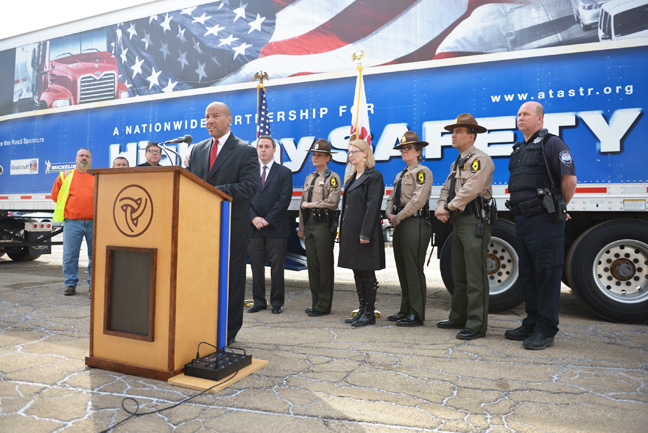
Pat Barcas/staff photographer
Illinois Tollway Chief of Staff Mike Stone reminds motorists that using a cell phone while driving without a hands free device is illegal in Illinois.
By Pat Barcas
Staff writer
Thursday, April 3, 2014
Email Pat Barcas at pat@foxvalleylabornews.com
CHANNAHON — With the proliferation of on-the-go electronic devices taking over the interiors of cars and trucks, drivers are getting more and more distracted, which means big trouble for the men and women who labor on the side of Illinois highways.
“Most job sites are not behind barrier walls. At most, our workers are protected by their equipment in front of them, and that’s it,” said John Bryan, president of Geneva Construction and board member of the Illinois Road and Transportation Builders Association. “It just takes an instant for a tragedy to occur.”
Bryan was among the officials who spoke April 7 in Channahon as part of the kickoff of National Work Zone Awareness week by the Illinois Department of Transportation. Now that winter is winding down and construction season is starting, IDOT is aiming to reduce severe crashes and fatalities on Illinois roadways.
It’s especially important for motorists to be patient this spring, with multiple construction projects underway on the tollways, and patching up of the roads after a harsh winter.
“Motorists need patience. Workers get stuff thrown at them all the time just from people who were inconvenienced for a minute,” said Bryan. “I have 120 employees, they all have children. They’re out there just doing their job and deserve to be safe.”
Mike Stone, chief of staff, Illinois Tollway, pointed out the new “Drop it and Drive” slogan for cell phone usage. It’s now illegal in Illinois to use a cellphone while driving without a hands free device.
“Be conscious and be courteous. It all boils down to that. You can’t be alert if you’re talking, texting, or tweeting on your cell phone. Drop it and drive,” said Stone.
Mike Sturino, president and CEO of the Illinois Road and Transportation Builders Association, held up his own phone amidst the traffic noise of nearby I-55.
“This cell phone plus your vehicle means you’re more likely to see a state trooper,” he said. “The average time spent looking at a text is 4.6 seconds. In that time you can travel the length of a football field — essentially blindfolded.”
Stone stressed Illinois’ Move Over Law, which requires motorists to slow down and change lanes if possible when approaching an emergency vehicle on the shoulder.
“By taking these simple precautions, drivers will not only protect the lives of workers, police officers, and other first responders, but also their own lives and those of their fellow motorists,” said Stone.
“These workers are wives and husbands, mothers and fathers, sisters and brothers — they’re not just nameless faceless people. They deserve all the respect a motorist can give, and that means slowing down in a work zone, paying attention, keeping off your cell phone, and never texting and driving,” said Sturino.
